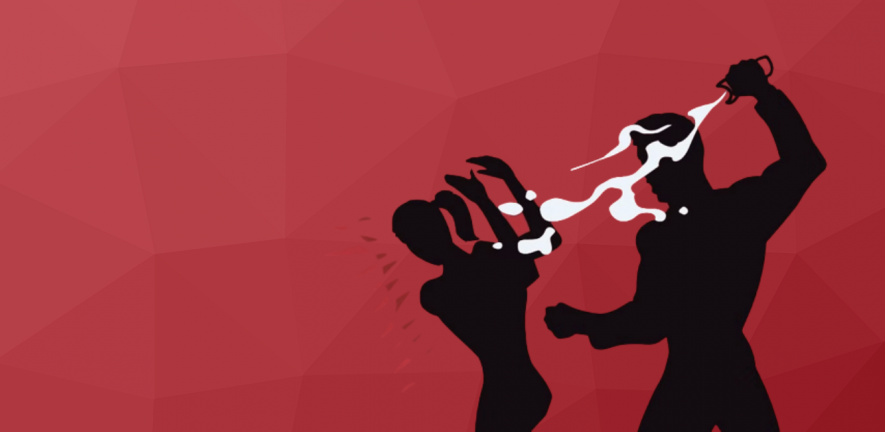Delhi Acid Attack: Weak Laws a Scar on Right to Dignity!

THE national capital of Delhi was shaken to the core when a 17-year-old girl was attacked by two bike-riding assaulters who splashed acid on her near the Dwarka Metro station around 7.30 a.m. on Wednesday, 14 December.
The Class 12 student was rushed to Safdarjung Hospital and is now out of danger despite suffering seven to eight per cent burns to her eyes and cheeks. The girl was supposed to sit for the Common Law Admission Test on December 18 in order to get admission into a National Law University.
The victim was on her way to school with her younger sister when the incident took place. She was attacked with hazardous acid minutes after leaving home, causing her younger sister, who was with her, to rush back and inform her parents, while the teenager was helped by local shopkeepers to wash off the acid with milk.
The three suspects, Sachin Arora, Virendra Singh, and Harshit Agarwal, have been arrested by Delhi police. The accused confessed to buying the acid from the online retail store Flipkart during interrogation. The incident was retaliation against the 17-year-old for quitting her ‘friendship’ with one of them.
The main mastermind, 20-year-old Arora, knew the schoolgirl, but the two had a falling out in September this year. As a result, he and his friend Agarwal plotted the acid attack. Singh, who was not present during the attack, had moved Arora’s smartphone to a different area so that his whereabouts couldn’t be traced.
Explanation 1 of Section 326B of the Indian Penal Code (‘IPC’) describes acid as “any substance which has acidic or corrosive character or burning nature, that is capable of causing bodily injury leading to scars or disfigurement or temporary or permanent disability”. The Supreme Court has labelled acid attacks “worse than murder”. According to National Crime Records Bureau data, there were 150 acid attack cases in 2019, 105 in 2020, and 102 in 2021. West Bengal and Uttar Pradesh lead the list of states with incidence of such cases, accounting for over half of the cases.
Also read: Where is the Justice For Victims of Acid Attacks in India?
What is law dealing with acid attacks?
An acid attack is defined as the act of throwing acid on an individual with the aim to cause harm, injury, or death. The individual who throws acid does it out of rage, resentment and envy. Acid throwing can result in burn scars, blindness, and other disabilities. Acid-throwing causes bodily, psychological, and societal damage.
Section 326A of the IPC prohibits using acid to injure another person permanently or partially. The minimum term of imprisonment for this offence is ten years in jail, but it can be increased to life imprisonment, and a fine, including the victim’s medical expenses.
The IPC addresses the deliberate throwing or attempted throwing of acid under section 326B. A fine and a minimum of five years in jail, with a potential increase to seven years, will be imposed as punishment for the offender.
The Supreme Court said that despite the judgment in the Lakshmi case, acid is still readily available to most of the population in India. Even today, there is still no verification required to purchase a bottle of acid from a kirana store or online due to a lack of implementation of the law.
The Criminal Procedure Code’s (‘CrPC’) Section 357A provides a general provision on compensation schemes for victims of criminal offences who have suffered any loss or harm, and courts have since issued an order requiring the accused to make compensation payments.
All local hospitals, both public and private, are required to offer victims free emergency first assistance, as per Section 357C of the CrPC. The Union Government must ensure that these laws are adequately applied to protect victims and their dependents. Although the culprits may get fines, prison time, or both, the survivors’ life will be changed irrevocably, and there may not be many chances for recovery.
How is the sale of acid governed?
Nitric, sulfuric and hydrochloric acids are readily accessible in the market. The sale or purchase of acids is regulated by the local government and any unlawful conduct is not subject to a bond requirement. State governments in India regulate the sale of acid. The Supreme Court created some national safeguards laws, making a license essential for the selling of acid, in the wake of its landmark ruling in Lakshmi versus Union of India in 2015.
The Poisons Act, 1919 mandates shops that sell acid to be registered. An ID card and an explanation of the reason for the purchase of acid are required for the buyer. No one under the age of 18 years is allowed to purchase acid. The penalty for breaking the law is Rs 50,000. Stores that sell acid are required to keep a record of sales and purchases.
The rule reads, “Over-the-counter sale of acid is prohibited unless the seller maintains a log/register recording the sale of acid, which will contain the details of the person(s) to whom acid(s) is/are sold and the quantity sold. The log/register shall contain the address of the person to whom it is sold.”
The Supreme Court in Parivartan Kendra versus Union of India (2015) noted that the success of any law is determined by its implementation. It said that despite the judgment in the Lakshmi case, acid is still readily available to most of the population in India. Even today, there is still no verification required to purchase a bottle of acid from a kirana store or online due to a lack of implementation of the law. Toilet cleansers that use deadly hydrochloric acid are marketed in plastic bottles and cost just Rs. 200 to Rs. 250 on the two biggest online retailers, Flipkart and Amazon.
What are the relief and rehabilitation schemes for acid attack victims?
The National Legal Services Authority’s (‘NALSA’) NALSA (Legal Services to Victims of Acid Attacks) Scheme, 2016, provides acid attack victims with the immediate assistance they need. The Supreme Court ordered that victims of acid attacks must receive free medical care as well as a minimum of three lakh rupees in compensation. The government has increased the payment to up to ten lakh rupees, depending on the severity of the injury, and if the victim dies, the family gets awarded the same amount.
Courts have mandated that reimbursement for rehabilitation costs be granted within two months, according to the National Commission for Women. Under the Prime Minister’s National Relief Fund, female acid attack victims also get relief of one lakh rupees.
It is challenging for someone to get to a hospital with a burns ward in a village or a small town. A woman who has suffered an acid attack could require at least 40 to 50 reconstructive procedures. States must provide mechanisms and funds to pay for these operations as well as the victims’ travel expenses to hospitals
The victim or their dependents are permitted to submit a request for compensation to the State or District Legal Services Authority in cases where the victim is recognised but the trial doesn’t occur because the offender cannot be located or identified. After a thorough inquiry and verification, the authorities are mandated to pay the victim their losses.
Under the CrPC’s section 357A, each state government’s cooperation with the Union Government is required to devise a strategy for distributing funds to victims or their dependents who have incurred loss or harm.
The Rights of Persons with Disabilities Act, 2016 permits survivors to get a disability certificate. Those with 40 per cent or more ‘disfigurement’ are eligible for government employment reservations. They are also entitled to several benefits under Chapters VI and VII of the Act, such as free education for their children. The private sector must have an equality policy to accommodate such survivors.
Why are we lacking in aiding the survivors?
Alok Dixit of the Stop Acid Attacks campaign pointed out that it is challenging for someone to get to a hospital with a burns ward in a village or a small town. A woman who has suffered an acid attack could require at least 40 to 50 reconstructive procedures. States must provide mechanisms and funds to pay for these operations as well as the victims’ travel expenses to hospitals.
Rehabilitation for acid attack victims becomes more challenging due to the high cost of cosmetic procedures. Their skin suffers long-term harm. Even after their multiple surgeries, they suffer from unemployment, financial dependence, and sometimes blindness. They are left with unfulfilled aspirations.
Every person’s right to life and liberty is guaranteed under Article 21 of the Constitution. According to one interpretation, this covers victims of acid assaults and includes their right to live with dignity. The victims should get proper training for relevant jobs so they can sustain themselves.
Extra efforts must be made for the social and emotional well-being of acid attack survivors. One acid attack can change everything in the life of a victim, who not only battles for her life in the hospital but fights every day with the society. An acid attack survivor’s life is impacted in every way, and her socioeconomic situation is totally shattered. Survivors of acid attacks lose their employment, and their lives change drastically. The lack of stringent laws and their non-implementation gives license to criminals, who are using acid as a tool to suppress women and their dreams to live with dignity.
Get the latest reports & analysis with people's perspective on Protests, movements & deep analytical videos, discussions of the current affairs in your Telegram app. Subscribe to NewsClick's Telegram channel & get Real-Time updates on stories, as they get published on our website.
























